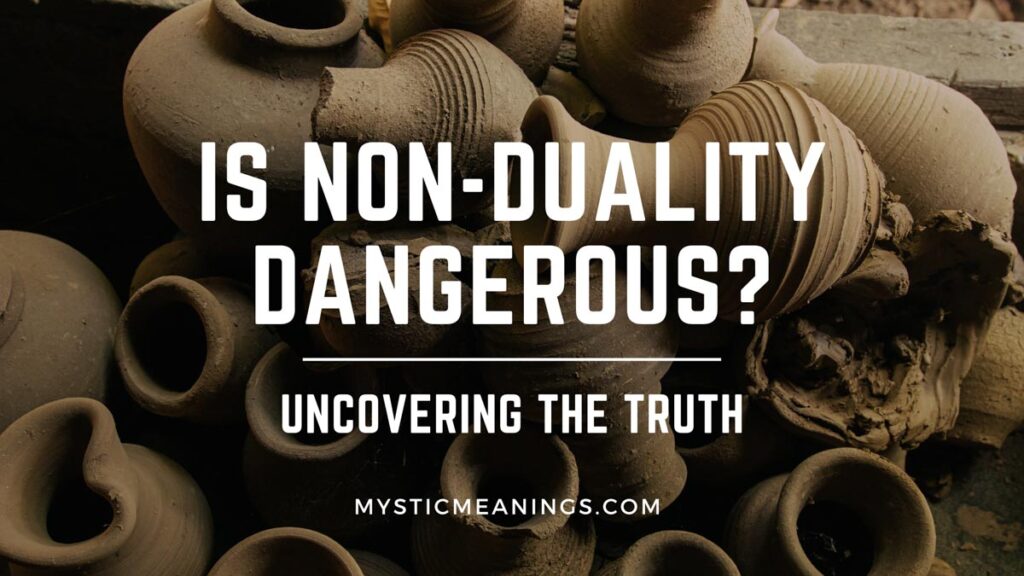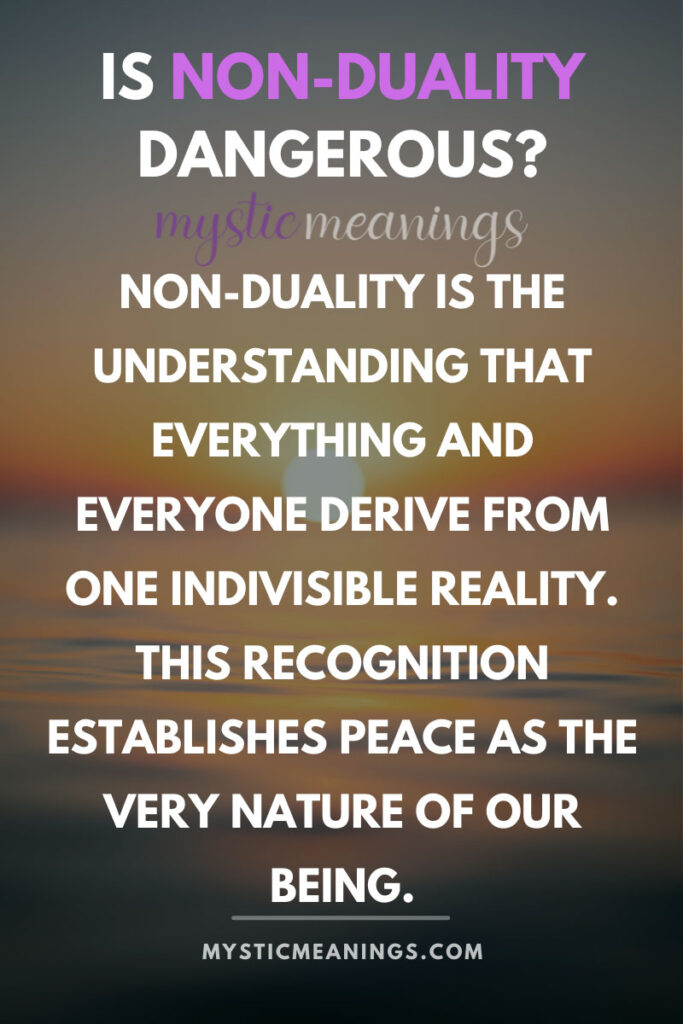No, non duality is not dangerous. According to traditional non-dual philosophies, non-duality, or rather non-dual consciousness, is the foundation of awareness which is peaceful by nature.
Relax your mind, be aware, and let’s dive in.

A Brief Introduction to Non Duality
The term non-duality is derived from the Sanskrit word, “Advaita.” Advaita means “not two” and the “identification of the self” (Atman) with the “ground of reality,” (Brahman).
You may even call this understanding as the union of God and man, where you can see the “Brahman” or the “absolute truth” in you with closed eyes and around you with open eyes. This is the very basis of Hindu Vedanta philosophy.
Non duality says that pure consciousness is the ultimate reality. This pure consciousness or non-dual awareness may be the foundation of eliminating any difference between a subject and an object. It preaches that you are no longer just a witness to everything occurring around you, and you are what you are beholding.
To put it simply, you are the mountain stretch lying in front of you, and you are the songs of a bird filling your ears.
You may say that there is some element of non-duality in every culture. Besides, non-dual awareness is a completely human experience, underlying your perceptions about yourself, the world, and beyond. So, it would be great if we go for a deeper dive into understanding non-duality.
What is Non Duality: Is It Dangerous?
We can call consciousness the ultimate mystery of the world. Now, what is consciousness? It’s the way we see the entire world, try to perceive realities, make decisions and behave in a certain way.
Non-duality is associated with the ultimate consciousness where we integrate different experiences into a whole or one. Ultimate consciousness also tells us to be watchful of our thoughts, and use them rationally. There is no scope for being propelled by the thoughts obsessively.

Non duality is not a dangerous understanding. It frees us from the slavery of ego and helps us to look beyond mental divisions and separations in the mind. We become able to see an enriched, deeper, and subtler reality going beyond the stringent mindset of duality.
If we discuss the pervasive process of human decision-making, we will see that there is a tendency in human beings to judge everything very quickly. These judgments are often full of faults, and we get a chance to rectify them only after we have suffered a lot. But the higher consciousness or non-dualistic thinking saves us from making these faults.
Non-duality also keeps us away from defining anything in a simplistic way. It teaches that reality is open and full of possibilities. Besides, we need to have the patience to understand the mystery and ambiguity attached to realities.
Moreover, non-dualistic thinkers have a better understanding of reality as they do not let their preoccupations, biases, or expectations impact their encounters with reality and people.
Non Duality and Consciousness
If we go by Hegel’s Dialectics, we will see that this method assumes the existence of a proposition or thesis, an antithesis or denial of the thesis, and a synthesis where two contradictory ideas are made compatible with each other to give birth to a new proposition.
This method of Hegel’s Dialectics can also be associated with the mystical concept of a third eye, where the inner realm and the reality around you get transcended to a greater level of consciousness. Then, this higher level of consciousness or non-dualistic thinking may work as an independent force that helps to give better clarity about everything going around.
One of the best ways to adopt a non-dualistic approach is mindful meditation. In this way, you will become more focused on fixing the faulty mental labels generated initially.
Another way to be attuned to non-dualistic thinking is to accept the occurrences in the world with an open mind, awe, gratitude, sensibility, and feelings. Thus, we can keep ourselves away from forming quick judgments about anything.
Examples of Non-Duality Throughout History
If we go down the alley of history, we will find some examples of non-dualistic consciousness.
There is deep non-dualistic thinking associated with John F. Kennedy’s response to the “Cuban Missile Crisis of 1962.” He took a patient stance and was open to analyzing the consequences of the proposed responses to this problem.
JFK even avoided making quick and extreme decisions like declaring war or remaining passive. He finally had a deeper understanding of the situation, and he came up with a more rational or “third eye” response of a “naval military blockade” to get rid of the crisis.
Again, Mahatma Gandhi’s non-violent movement for the Freedom of India can be seen as a non-dualistic approach. He did not quickly start a violent operation against the British Raj. At the same time, he did not submit to their slavery.
Rather, he used his passive resistance, patience, and openness to force the British to leave India with the alternative process of non-violence. We can even call the response of Martin Luther King Jr to the 1960’s Civil Rights Movement in the US a non-dualistic approach.
Furthermore, we can explain our dreams from a non-dualistic approach. Going by non-dualism, our mind and body become one in our dreams. In other words, we are us and all the other characters appearing in our dreams. For example, you may see that someone is saying something to you in a dream. Here, you are not only the listener but also the speaker.
What is Advaita Vedanta?
Advaita Vedanta, as a school of Hindu spiritual practices and philosophies, is three thousand years old. Literally, Advaita, a Sanskrit word, means “not two.” The most revered preacher of this concept is Adi Shankaracharya.
If we go deeper, we will see that one of the main goals of Advaita is “Moksha,” or liberation or enlightenment. We can also interpret it as better self-realization or a spiritual awakening. Now, what is this liberation or freedom all about?
There are two constant elements in a living human being. There are our thoughts, and there are our present encounters with the world. So, we are burdened with this constant conflict or pain of duality. Moksha in Advaita frees us from this duality by liberating us from our world of thoughts. So, there are no thoughts, and only the present experiences are absolute and one.
Once again, Advaita says that we can only achieve this liberation or enlightenment (a greater consciousness) only through our own eyes. It is like looking for the ultimate wisdom on your own and not by following some scribbles, scriptures, or preachings. Adi Shankaracharya said that we could only know what the Moon looks like if we see it with our own eyes.

Advaita Vedanta and Idealism: Understanding Non-Duality
We can also try to understand Advaita Vedanta from the point of view of quantum physics. The concept of idealism lies at the core of quantum physics. Similar to Advaita Vedanta, idealism says that the existence of any element is solely dependent on our perceptions.
For example, assume there is a book lying in front of you. Now, what is it to you? Your five sensory organs are recording some specific sensations presently, and then the past experiences in your brain are processing these sensations. As a result, you are perceiving a book as a book.
In other words, everything you see with your open or closed eyes is the Brahman, which is the absolute reality. According to Advaita Vedanta, “Brahman” cannot be born, or changed, and it is immortal. And this absolute truth depends on how you perceive it.
If we talk about the sun, it does not rise or set, and there is no darkness. However, as human beings, we see the sun rising and setting regularly, causing day and night.
The truth is different if we see it from the sun’s perspective and from our perspective. However, in Advaita Vedanta, this contradiction does not refer to “two truths” or “two realities.” It means the truth, or Brahman, is absolute, and it is only changing based on how one perceives it.
Non Duality in Christianity
There are various elements of non-duality in Christianity. Let’s have a look at them.
The eastern orthodox churches and the Byzantine Catholic churches illuminated us about the transformative process of “Theosis” or “Deification.” We can also call the process “Apotheosis, ” meaning “making divine.”
Now relating this process to non-duality, we can say that the Doctrine of Deification preaches us to find salvation through a process where our soul becomes the God. So, the God and our souls are not two but one.
Further, if we follow Martin Luther’s preaching of salvation, we will see the same reflection as the Doctrine of Deification. Luther said that God had become man so that men could become God. Here also, there is a unity between the worshipped and worshipper, the very essence of non-duality.
Once again, the Roman Catholic Saint Gregory of Nyssa preached that there could be no interruption when one is rising to God. So, the ultimate journey here is to be one with the Supreme Lord.
Even in recent times, many scholars, authors, and priests have found non-duality in Christianity. They say that Jesus was divine and human at the same time, and that is the core of Christian beliefs. This concept further confirms the association of non-duality with Christianity.
Biblical Foundation of Non-duality
If we look at verse 17:11 in John, we will see that Jesus is praying for his disciples and asking the Holy Father to protect the disciples in the power of his name and the name given to Jesus, as they are one and they can be one.
Again in John 17:21, Jesus is praying for his believers and saying that the Holy Father is in him and he is inside the Holy Father.
I pray that they will all be one, just as you and I are one—as you are in me, Father, and I am in you. And may they be in us so that the world will believe you sent me.
Bible, John 17:21 New Living Translation
Lastly, in John verse 17:23, Jesus is praying for “complete unity,” which again is the very essence of non-duality.
Colossians 1:19 says that all the fullness of the deity in bodily form can be found in Jesus. So, here the deity is inside Jesus, not any separate entity. Again in Colossians 2:9-10, it is said that you have been brought to completeness in Christ.
More Biblical foundations of non-duality can be found in Ephesians 1:22-23, Ephesians 3:19, and Ephesians 4:13.
Non-Duality Found in Other Religions
Along with Hinduism and Christianity, non-duality is prominently associated with Buddhism and Taoism.
In Buddhism, non-duality is related to “Advaya,” which means not two. Though Lord Buddha, in his earliest preachings, did not use the term, it can be found in various “Mahayana Sutras.”
Advaya in Sanskrit Buddhist texts is also connotated as the middle way that is bringing together two extreme paths of eternalism and annihilationism, and thus becoming one. Buddhism further says that the conflicts between two extremes should be avoided, and they should be brought into one to understand the ultimate truth or reality.
Unlike the Hindu school of Advaita Vedanta, Buddhist Advaya does not tell us to be in a thoughtless state and only know the present experience as the ultimate truth. As Indian Philosopher Nagarjuna has rightly pointed out that in Advaya, the conventional knowledge, or the knowledge you already have, is not separate from the ultimate truth. They are one.
Again, in the Madhyamaka school of the Mahayana Buddhist philosophy, it is said that Nirvana (ultimate liberation) and the Samsara (worldly sufferings) are not separate from each other. The “subtlest differences” can not be found in these two.
Similarly, there is a concept of non-duality in Taoism. It says that Tao is the origin of all elements of the world. Besides, the main concept of Taoism is trying to achieve perfection through the process of self-cultivation. Also, Taoism says that all the contradictory things are complementary elements of a bigger and non-dual whole.
So, is Non-Duality Dangerous?
Non-duality is not dangerous, and is rather an approach to “know thyself,” or enhance your self-awareness/consciousness. And this aspect of self-awareness or self-knowledge has found utmost importance in almost every culture or civilization.
Besides, non-duality teaches us to unify all the experiences we have into a whole or ultimate truth. Thus, we can be free of our ego and determine our actions with an understanding of the deeper reality.
If you’re ready, begin your spiritual journey today with these 5 essential steps.

